Abstract
Purpose
To compare the postoperative clinical outcomes after cataract surgery and implantation using the BunnyLens MF® and ReSTOR® multifocal intraocular lenses. ®
Methods
Sixty-five eyes implanted with multifocal intraocular lenses were divided into two groups involving either ReSTOR® (39 eyes) or BunnyLens MF® (26 eyes) lenses. In these two groups, the distant and near visual acuity, astigmatism, spherical equivalent, and contrast sensitivity test were examined at preoperative and postoperative 1 week, 8 weeks, and 24 weeks. We compared the clinical efficacy between the two groups before and after cataract surgery using statistical analysis.
Results
The mean value of distant and near visual acuity, and spherical equivalent of both groups after intraocular lens implantation were significantly improved, compared with the preoperative values (p < 0.05), while there was no significant differences between the two groups (p > 0.05). The means of postoperative distant and near visual acuity, astigmatism, and contrast sensitivity test were not significantly different between ReSTOR® and BunnyLens MF® lenses (p > 0.05). The mean numeric error of spherical equivalent at the final postoperative 24 weeks was −0.17 ± 0.50 diopters (D) for the ReSTOR® lenses and −0.34 ± 0.52 D for the BunnyLens MF® lenses (p > 0.05).
Conclusions
BunnyLens MF® and ReSTOR® lenses showed no significant difference in clinical efficacy, including distance and near vision, spherical equivalent error, and contrast sensitivity test after cataract surgery. However, it should be noted that BunnyLens MF® lenses had a tendency toward myopic shift compared with ReSTOR® lenses.
Go to : 
References
1. Evans JR, Fletcher AE, Wormald RP; MRC Trial of Assessment and Management of Older People in the Community. Causes of visual impairment in people aged 75 years and older in Britain: an add-on study to the MRC trial of assessment and management of older people in the community. Br J Ophthalmol. 2004; 88:365–70.
2. Oh JJ, Choi JS. Clinical results and optical quality of diffractive multifocal intraocular lens. J Korean Ophthalmol Soc. 2015; 56:1867–73.

3. Leyland M, Zinicola E. Multifocal versus monofocal intraocular lenses in cataract surgery: a systematic review. Ophthalmology. 2003; 110:1789–98.
4. Kohnen T, Allen D, Boureau C, et al. European multicenter study of the AcrySof ReSTOR apodized diffractive intraocular lens. Ophthalmology. 2006; 113:584.e1.

5. Chiam PJ, Chan JH, Aggarwal RK, Kasaby S. ReSTOR intraocular lens implantation in cataract surgery: quality of vision. J Cataract Refract Surg. 2006; 32:1459–63.

6. van der Linden JW, van der Meulen IJ, Mourits MP, lapid-Gortzak R. Comparison of a hydrophilic and a hydrophobic apodized abdominal multifocal intraocular lens. Int Ophtalmol. 2013; 33:493–500.
7. Toto L, Falconio G, Vecchiarino L, et al. Visual performance and biocompatibility of 2 multifocal diffractive IOLs: six-month abdominal study. J Cataract Refract Surg. 2007; 33:1419–25.
8. Alfonso JF, Fernández-Vega L, Amhaz H, et al. Visual function abdominal implantation of an aspheric bifocal intraocular lens. J Cataract Refract Surg. 2009; 35:885–92.
9. Vingolo EM, Grenga P, Iacobelli L, Grenga R. Visual acuity and contrast sensitivity: AcrySof ReSTOR apodized diffractive versus AcrySof SA60AT monofocal intraocular lenses. J Cataract Refract Surg. 2007; 33:1244–7.

10. Lee HS, Park SH, Kim MS. Clinical results and some problems of multifocal apodized diffractive intraocular lens implantation. J Korean Ophthalmol Soc. 2008; 49:1235–41.

11. Yun J, Ahn K, Lee DH, et al. Spheric, aspheric ReSTOR abdominal lens: three-month results and preoperative clinical factors influencing patient's satisfaction. J Korean Ophthalmol Soc. 2010; 51:14–21.
12. Zelichowska B, Rekas M, Stankiewicz A, et al. Apodized abdominal versus refractive multifocal intraocular lenses: optical and visual evaluation. J Cataract Refract Surg. 2008; 34:2036–42.
13. Alfonso JF, Fernández-Vega L, Baamonde MB, Montés-Micó R. Prospective visual evaluation of apodized diffractive intraocular lenses. J Cataract Refract Surg. 2007; 33:1235–43.

14. Alfonso JF, Puchades C, Fernández-Vega L, et al. Visual acuity comparison of 2 models of bifocal aspheric intraocular lenses. J Cataract Refract Surg. 2009; 35:672–6.

15. Schauersberger J, Amon M, Kruger A, et al. Comparison of the abdominal of 2 foldable intraocular lenses with sharp optic edges. J Cataract Refract Surg. 2001; 27:1579–85.
16. Buehl W, Findl O, Menapace R, et al. Effect of an acrylic abdominal lens with a sharp posterior optic edge on posterior capsule opacification. J Cataract Refract Surg. 2002; 28:1105–11.
17. Vámosi P, Csákány B, Németh J. Intraocular lens exchange in abdominals with negative dysphotopsia symptoms. J Cataract Refract Surg. 2010; 36:418–24.
18. Radford SW, Carlsson AM, Barrett GD. Comparison of abdominal dysphotopsia with Akreos Adapt and SN60-AT intraocular lenses. J Cataract Refract Surg. 2007; 33:88–93.
19. Osher RH. Negative dysphotopsia: long-term study and possible explanation for transient symptoms. J Cataract Refract Surg. 2008; 34:1699–707.

20. Kim JA, Ha AN, Kwon JW, et al. Clinical characteristics and abdominal's satisfaction in pseudophakic negative dysphotopsia. J Korean Ophthalmol Soc. 2014; 55:669–78.
21. Cheon MH, Lee JE, Kim JH, et al. One-year outcome of monocular implant of aspheric multifocal IOL. J Korean Ophthalmol Soc. 2010; 51:822–8.

22. Lee JS, Yoon TJ, Ahn JH. Comparison of the clinical effects of abdominalation of aspheric and spherical intraocular lenses. J Korean Ophthalmol Soc. 2009; 50:1514–9.
23. Moon SD, Chung J, Kim MS. abdominal astigmatic changes in abdominal surgery. J Korean Ophthalmol Soc. 1996; 37:1427–34.
24. Park CY, Chuck RS. Residual refractive error and visual outcome after cataract surgery using spherical versus Aspheric IOLs. Ophthalmic Surg Lasers Imaging. 2011; 42:37–43.

25. Kim S, Kim MS. The study on target refraction to improve visual quality in patients implanted with multifocal IOL. J Korean Ophthalmol Soc. 2012; 53:223–9.

26. Leone JF, Mitchell P, Morgan IG, et al. Use of visual acuity to screen for significant refractive errors in adolescents: Is it reliable? Arch Ophthalmol. 2010; 128:894–9.
Go to : 
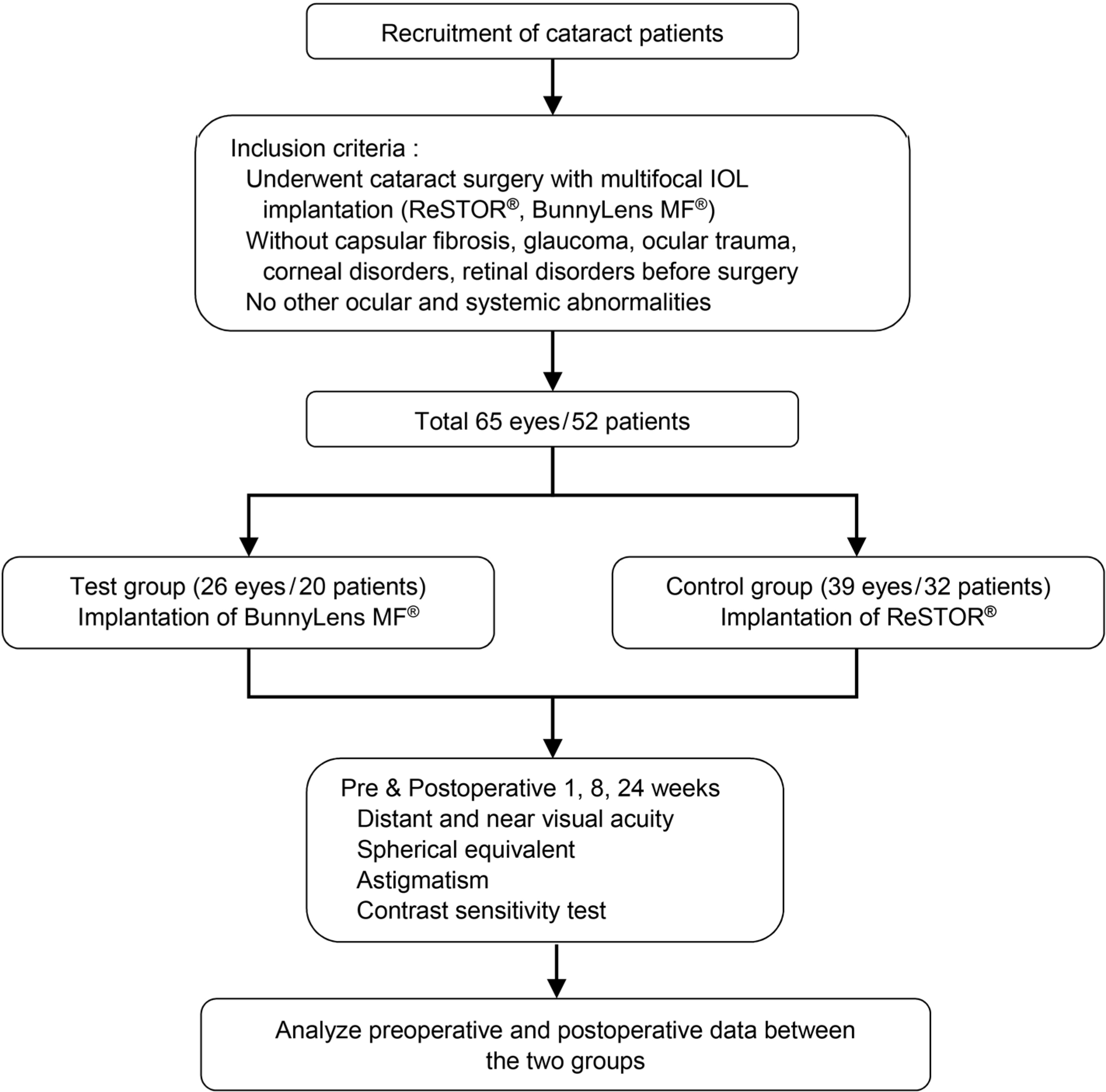 | Figure 1.Flow diagram of the study. Patients were selected according to the inclusion criteria and their medical records were retrospectively analyzed. Sixty-five eyes were divided into two groups: ReSTOR® and BunnyLens MF®. In these two groups, distant and near visual acuity, spherical equivalent and contrast sensitivity test were examined at preoperative and postoperative time points. IOL = intraocular lens. |
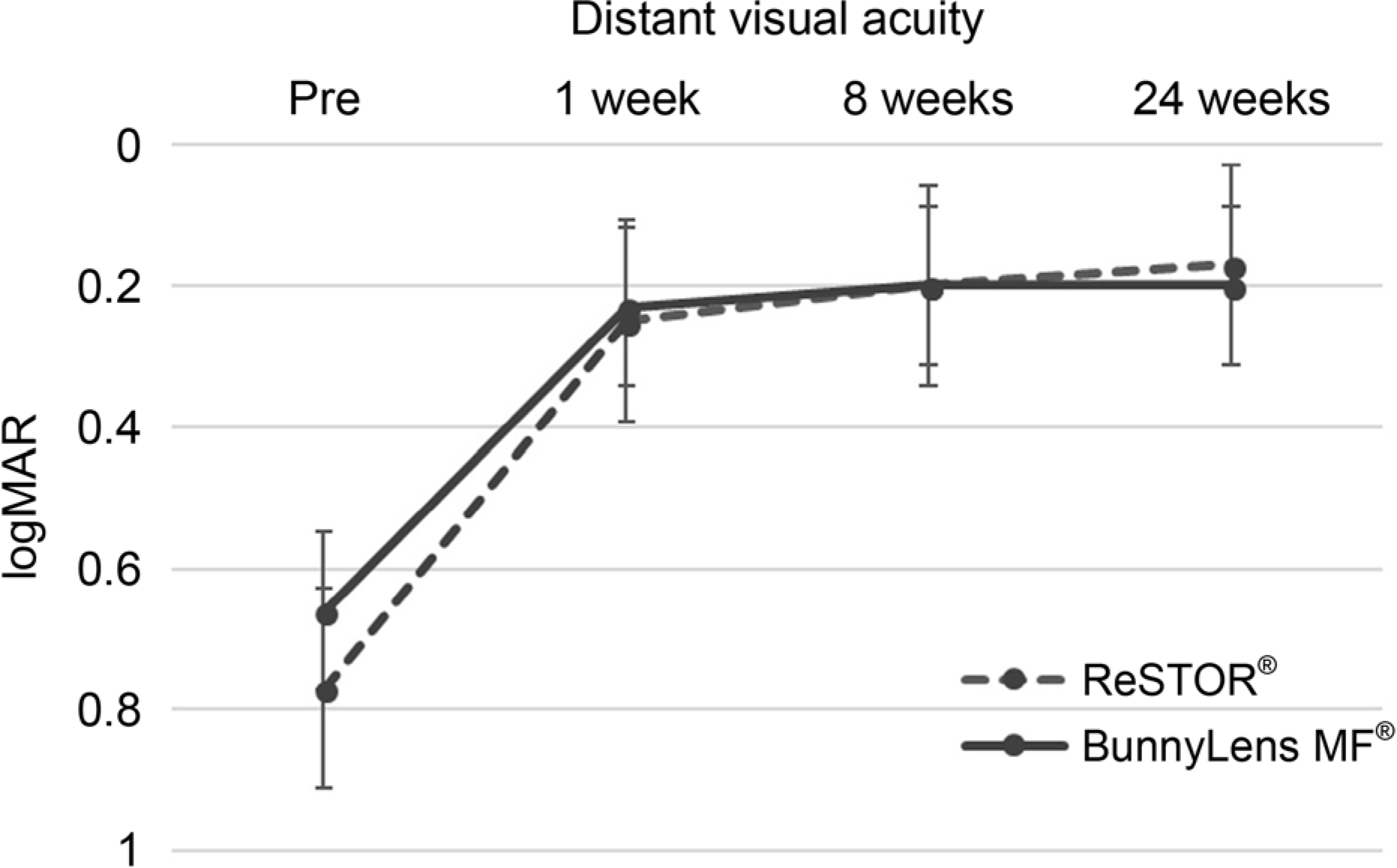 | Figure 2.Comparison of postoperative distant UCVA (logMAR). Distant UCVA improved over time after cataract surgery. There was no significant difference between the two groups (p > 0.05, Student's t-test). Pre = preoperative state; UCVA = uncorrected visual acuity; MF = multifocal intraocular lens. |
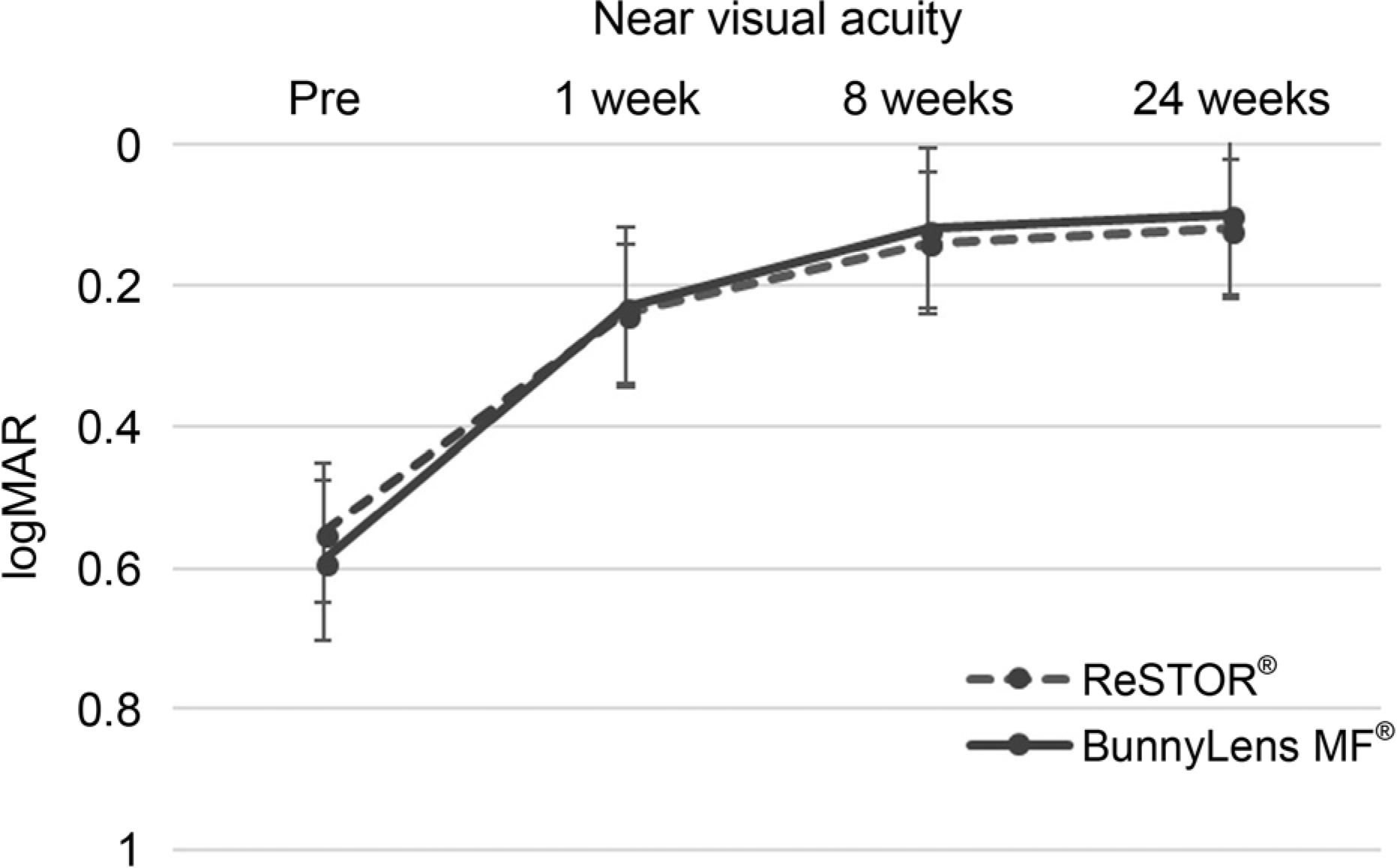 | Figure 3.Comparison of postoperative near UCVA (logMAR). Near UCVA improved over time after cataract surgery. There was no significant difference between the two groups (p>0.05, Student's t-test). Pre = preoperative state; UCVA = uncorrected visual acuity; MF = multifocal intraocular lens. |
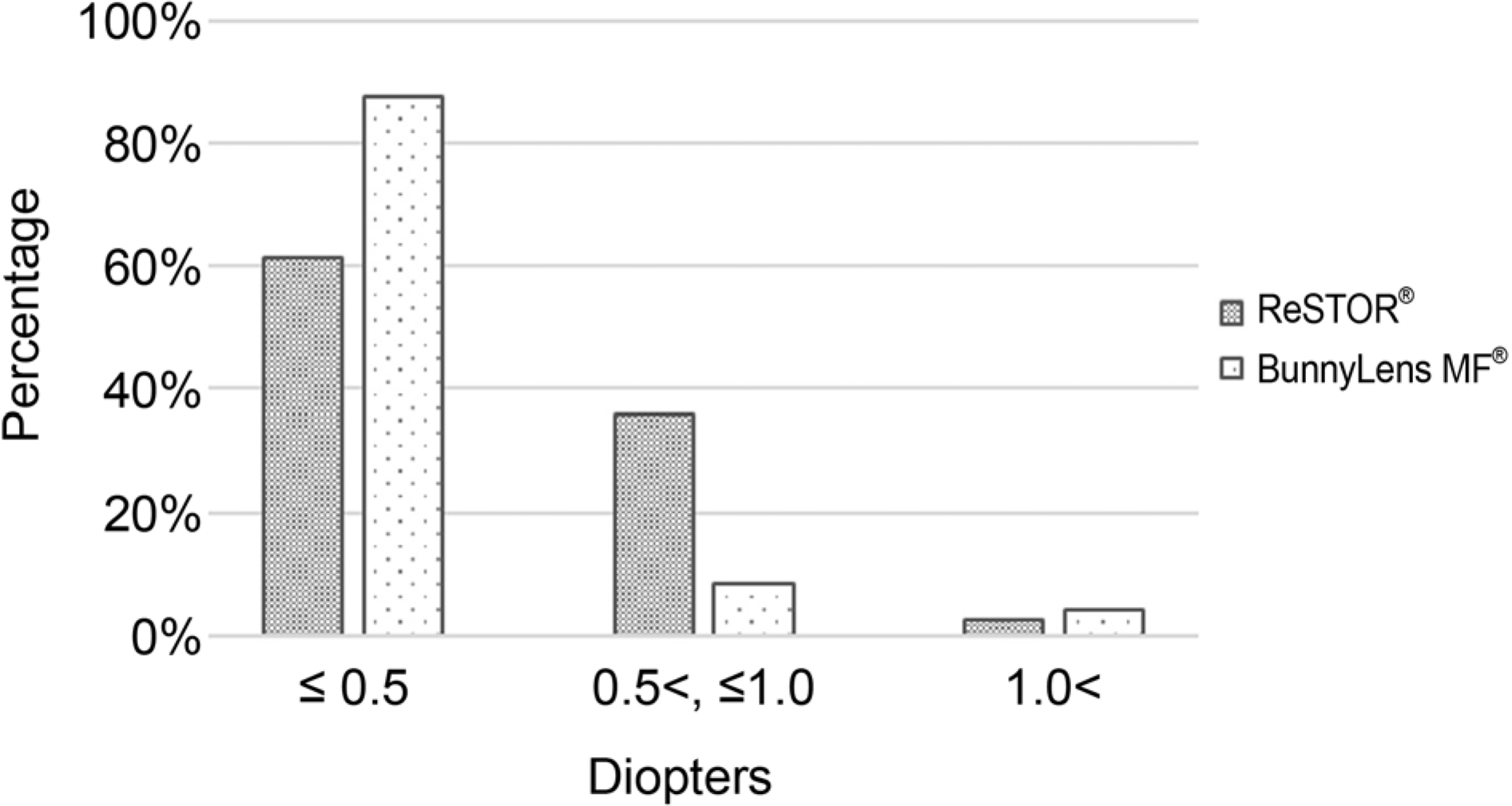 | Figure 4.Comparison of ratio of postoperative absolute value of spherical errors. Most postoperative spherical errors were less than 0.5 D in both groups at the postoperative 24 weeks. There was no statistically significant difference in post-operative percentage of section in both groups (p = 0.078, Linear by linear association). D = diopter; MF = multifocal intraocular lens. |
 | Figure 5.Comparison of postoperative total astigmatism (diopters). The total astigmatism was the highest at one week after surgery, and decreased over time. There was no significant difference between the two groups (p > 0.05, Student's t-test). Pre = preoperative state; MF = multifocal intraocular lens. |
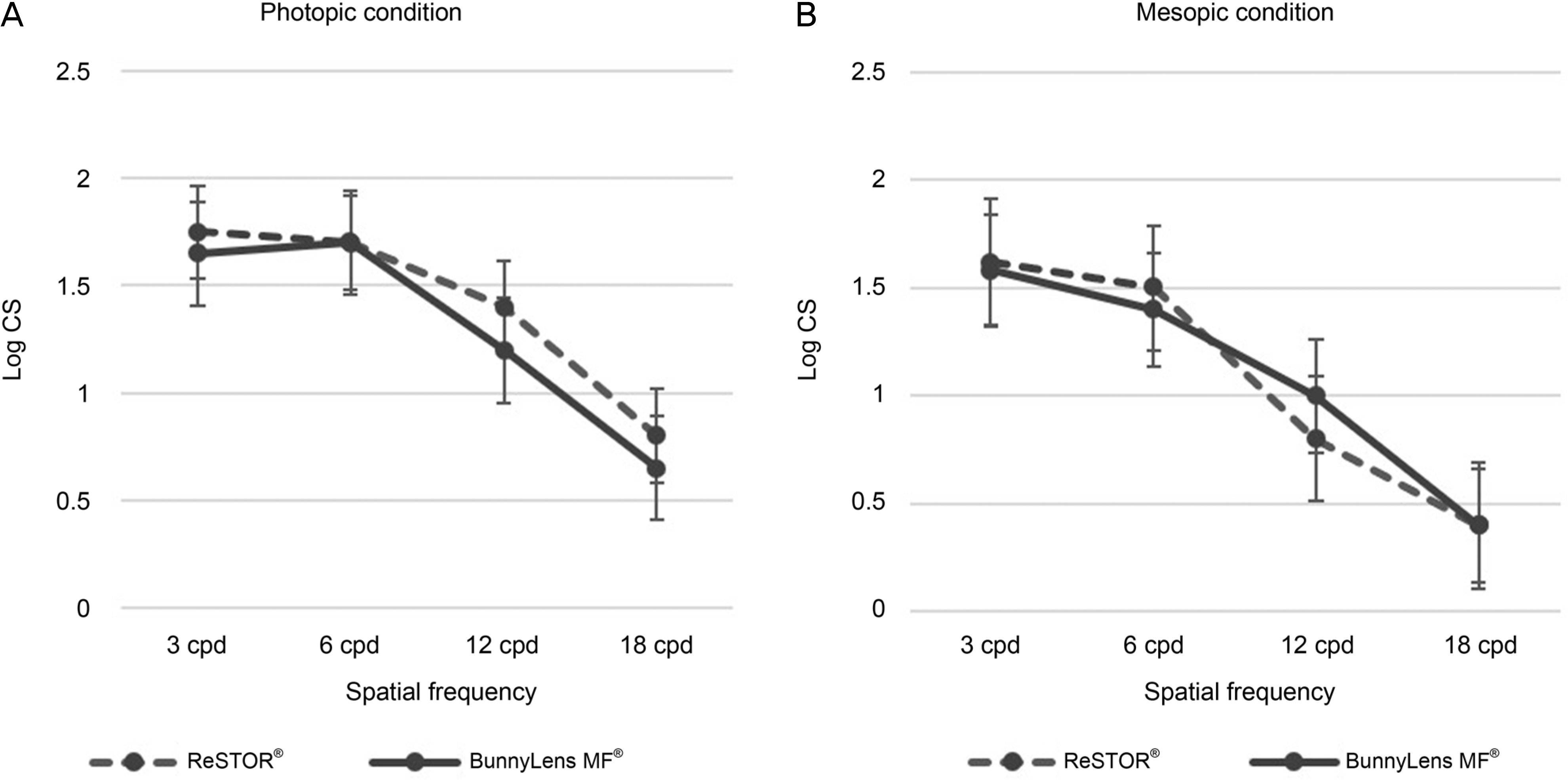 | Figure 6.Comparision of the postoperative value of contrast sensitivity at postoperative 8 weeks. (A) Photopic condition. (B) Mesopic condition. There was no significant difference between the two groups at all frequencies of photopic and mesopic condition (p > 0.05, Student's t-test). Log CS = log value of constrast sensitivity; cpd = cycles per degrees; MF = multifocal intraocular lens. |
Table 1.
Demographics of study group, ReSTOR® and BunnyLens MF®
| ReSTOR® | BunnyLens MF® | p-value* | |
|---|---|---|---|
| Eyes/patients (cases) | 39/32 | 26/20 | |
| Sex (male:female, cases) | 24:15 | 8:18 | |
| Age (years) | 57.18 ± 12.88 | 57.46 ± 14.46 | 0.936 |
| Axial length (mm) | 24.43 ± 1.46 | 23.84 ± 1.16 | 0.078 |
| Preoperative BCVA (logMAR) | 0.77 ± 0.48 | 0.66 ± 0.34 | 0.796 |
| Preoperative spherical equivalent (diopters) | −0.88 ± 2.97 | −0.52 ± 2.49 | 0.613 |
| Preoperative spherical errors (diopters) | −0.40 ± 3.19 | −0.13 ± 2.98 | 0.762 |
| Preoperative total astigmatism (diopters) | −1.22 ± 0.92 | −1.25 ± 0.79 | 0.905 |
| Preoperative corneal astigmatism (diopters) | −0.82 ± 0.51 | −0.9 ± 0.50 | 0.653 |
| IOL power (diopters) | 18.97 ± 3.34 | 20.65 ± 2.22 | 0.028 |
Table 2.
Comparison with the postoperative mean numeric error of spherical equivalent of the two groups
| ReSTOR® | BunnyLens MF® | p-value* | |
|---|---|---|---|
| Postop. 1 weeks (diopter) | −0.13 ± 0.72 | −0.60 ± 0.47 | 0.002 |
| Postop. 8 weeks (diopter) | −0.16 ± 0.53 | −0.39 ± 0.71 | 0.141 |
| Postop. 24 weeks (diopter) | −0.17 ± 0.50 | −0.34 ± 0.52 | 0.177 |




 PDF
PDF ePub
ePub Citation
Citation Print
Print


 XML Download
XML Download